BSB119 Global Business Semester 1 2019: International Strategy Report
VerifiedAdded on 2023/04/11
|5
|1000
|171
Report
AI Summary
This report provides an assessment of international business strategies, focusing on export market selection, outsourcing destination analysis, and foreign direct investment (FDI) decisions. It uses socio-economic data to draw conclusions about market potential and business environments in different countries. The report also includes a comparison of licensing and direct export as market entry modes, recommending licensing for a technology company. A line graph is presented, and references are provided to support the analysis. Desklib offers this document along with a wealth of resources to aid students in their studies.
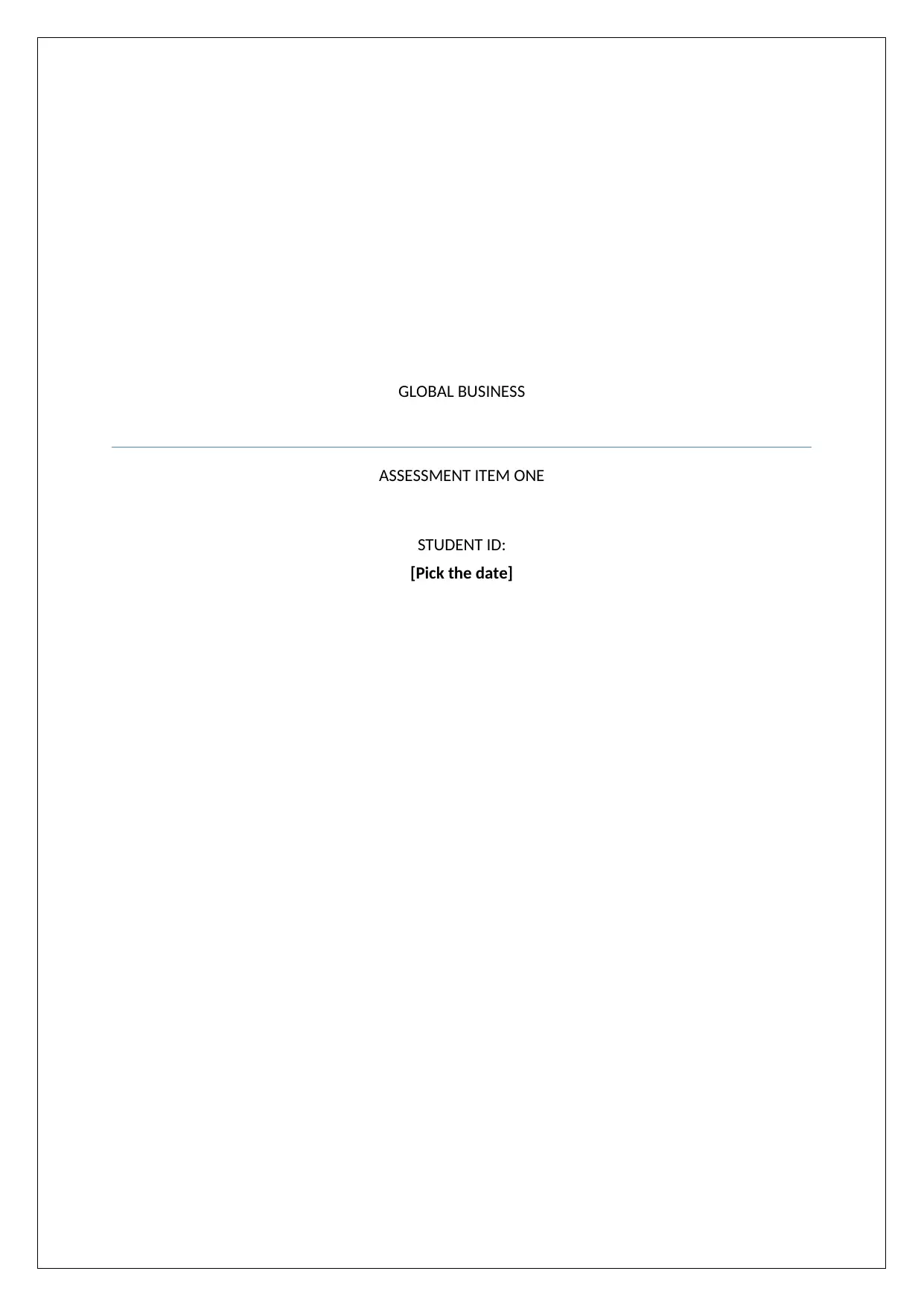
GLOBAL BUSINESS
ASSESSMENT ITEM ONE
STUDENT ID:
[Pick the date]
ASSESSMENT ITEM ONE
STUDENT ID:
[Pick the date]
Paraphrase This Document
Need a fresh take? Get an instant paraphrase of this document with our AI Paraphraser
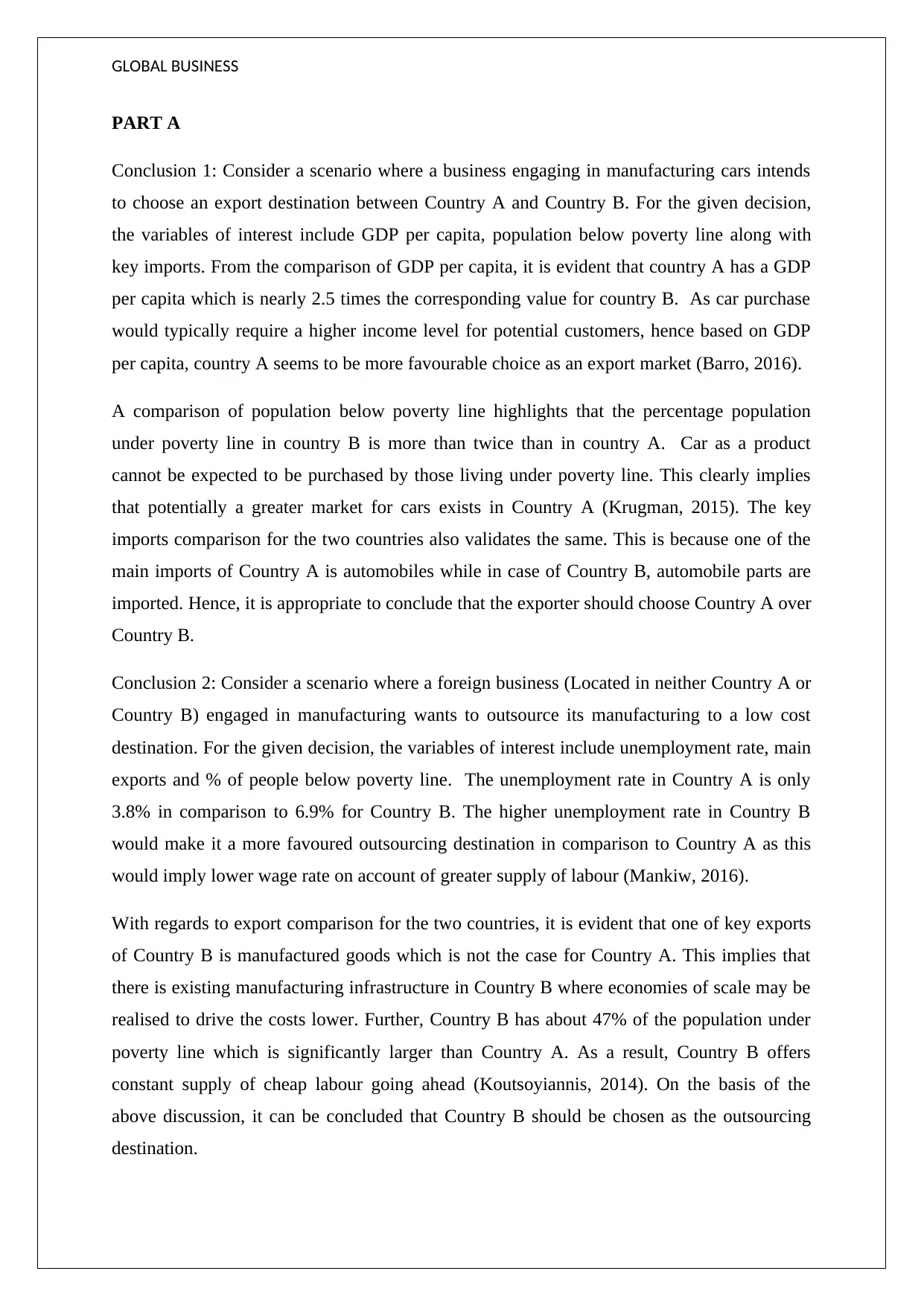
GLOBAL BUSINESS
PART A
Conclusion 1: Consider a scenario where a business engaging in manufacturing cars intends
to choose an export destination between Country A and Country B. For the given decision,
the variables of interest include GDP per capita, population below poverty line along with
key imports. From the comparison of GDP per capita, it is evident that country A has a GDP
per capita which is nearly 2.5 times the corresponding value for country B. As car purchase
would typically require a higher income level for potential customers, hence based on GDP
per capita, country A seems to be more favourable choice as an export market (Barro, 2016).
A comparison of population below poverty line highlights that the percentage population
under poverty line in country B is more than twice than in country A. Car as a product
cannot be expected to be purchased by those living under poverty line. This clearly implies
that potentially a greater market for cars exists in Country A (Krugman, 2015). The key
imports comparison for the two countries also validates the same. This is because one of the
main imports of Country A is automobiles while in case of Country B, automobile parts are
imported. Hence, it is appropriate to conclude that the exporter should choose Country A over
Country B.
Conclusion 2: Consider a scenario where a foreign business (Located in neither Country A or
Country B) engaged in manufacturing wants to outsource its manufacturing to a low cost
destination. For the given decision, the variables of interest include unemployment rate, main
exports and % of people below poverty line. The unemployment rate in Country A is only
3.8% in comparison to 6.9% for Country B. The higher unemployment rate in Country B
would make it a more favoured outsourcing destination in comparison to Country A as this
would imply lower wage rate on account of greater supply of labour (Mankiw, 2016).
With regards to export comparison for the two countries, it is evident that one of key exports
of Country B is manufactured goods which is not the case for Country A. This implies that
there is existing manufacturing infrastructure in Country B where economies of scale may be
realised to drive the costs lower. Further, Country B has about 47% of the population under
poverty line which is significantly larger than Country A. As a result, Country B offers
constant supply of cheap labour going ahead (Koutsoyiannis, 2014). On the basis of the
above discussion, it can be concluded that Country B should be chosen as the outsourcing
destination.
PART A
Conclusion 1: Consider a scenario where a business engaging in manufacturing cars intends
to choose an export destination between Country A and Country B. For the given decision,
the variables of interest include GDP per capita, population below poverty line along with
key imports. From the comparison of GDP per capita, it is evident that country A has a GDP
per capita which is nearly 2.5 times the corresponding value for country B. As car purchase
would typically require a higher income level for potential customers, hence based on GDP
per capita, country A seems to be more favourable choice as an export market (Barro, 2016).
A comparison of population below poverty line highlights that the percentage population
under poverty line in country B is more than twice than in country A. Car as a product
cannot be expected to be purchased by those living under poverty line. This clearly implies
that potentially a greater market for cars exists in Country A (Krugman, 2015). The key
imports comparison for the two countries also validates the same. This is because one of the
main imports of Country A is automobiles while in case of Country B, automobile parts are
imported. Hence, it is appropriate to conclude that the exporter should choose Country A over
Country B.
Conclusion 2: Consider a scenario where a foreign business (Located in neither Country A or
Country B) engaged in manufacturing wants to outsource its manufacturing to a low cost
destination. For the given decision, the variables of interest include unemployment rate, main
exports and % of people below poverty line. The unemployment rate in Country A is only
3.8% in comparison to 6.9% for Country B. The higher unemployment rate in Country B
would make it a more favoured outsourcing destination in comparison to Country A as this
would imply lower wage rate on account of greater supply of labour (Mankiw, 2016).
With regards to export comparison for the two countries, it is evident that one of key exports
of Country B is manufactured goods which is not the case for Country A. This implies that
there is existing manufacturing infrastructure in Country B where economies of scale may be
realised to drive the costs lower. Further, Country B has about 47% of the population under
poverty line which is significantly larger than Country A. As a result, Country B offers
constant supply of cheap labour going ahead (Koutsoyiannis, 2014). On the basis of the
above discussion, it can be concluded that Country B should be chosen as the outsourcing
destination.
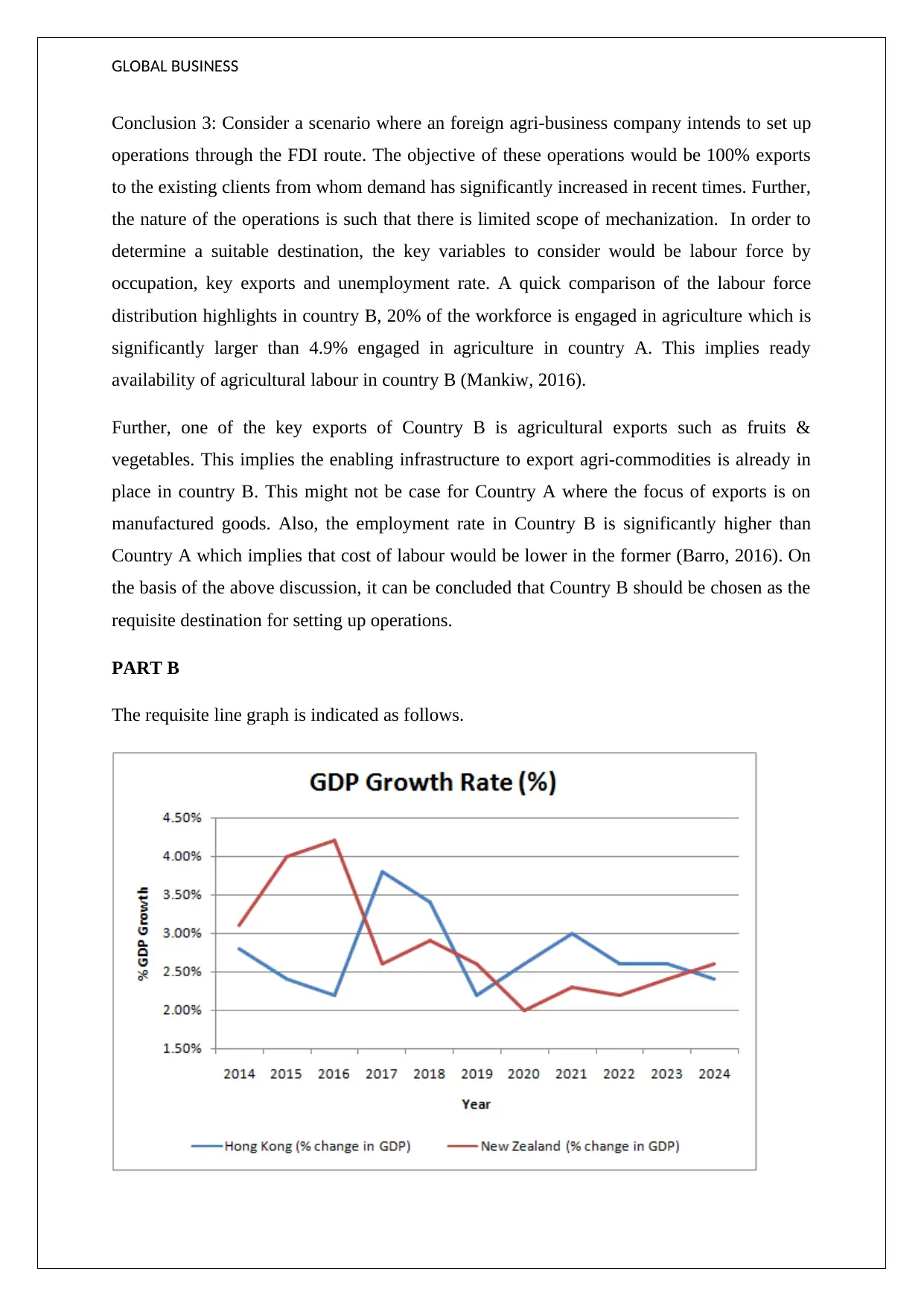
GLOBAL BUSINESS
Conclusion 3: Consider a scenario where an foreign agri-business company intends to set up
operations through the FDI route. The objective of these operations would be 100% exports
to the existing clients from whom demand has significantly increased in recent times. Further,
the nature of the operations is such that there is limited scope of mechanization. In order to
determine a suitable destination, the key variables to consider would be labour force by
occupation, key exports and unemployment rate. A quick comparison of the labour force
distribution highlights in country B, 20% of the workforce is engaged in agriculture which is
significantly larger than 4.9% engaged in agriculture in country A. This implies ready
availability of agricultural labour in country B (Mankiw, 2016).
Further, one of the key exports of Country B is agricultural exports such as fruits &
vegetables. This implies the enabling infrastructure to export agri-commodities is already in
place in country B. This might not be case for Country A where the focus of exports is on
manufactured goods. Also, the employment rate in Country B is significantly higher than
Country A which implies that cost of labour would be lower in the former (Barro, 2016). On
the basis of the above discussion, it can be concluded that Country B should be chosen as the
requisite destination for setting up operations.
PART B
The requisite line graph is indicated as follows.
Conclusion 3: Consider a scenario where an foreign agri-business company intends to set up
operations through the FDI route. The objective of these operations would be 100% exports
to the existing clients from whom demand has significantly increased in recent times. Further,
the nature of the operations is such that there is limited scope of mechanization. In order to
determine a suitable destination, the key variables to consider would be labour force by
occupation, key exports and unemployment rate. A quick comparison of the labour force
distribution highlights in country B, 20% of the workforce is engaged in agriculture which is
significantly larger than 4.9% engaged in agriculture in country A. This implies ready
availability of agricultural labour in country B (Mankiw, 2016).
Further, one of the key exports of Country B is agricultural exports such as fruits &
vegetables. This implies the enabling infrastructure to export agri-commodities is already in
place in country B. This might not be case for Country A where the focus of exports is on
manufactured goods. Also, the employment rate in Country B is significantly higher than
Country A which implies that cost of labour would be lower in the former (Barro, 2016). On
the basis of the above discussion, it can be concluded that Country B should be chosen as the
requisite destination for setting up operations.
PART B
The requisite line graph is indicated as follows.
⊘ This is a preview!⊘
Do you want full access?
Subscribe today to unlock all pages.

Trusted by 1+ million students worldwide
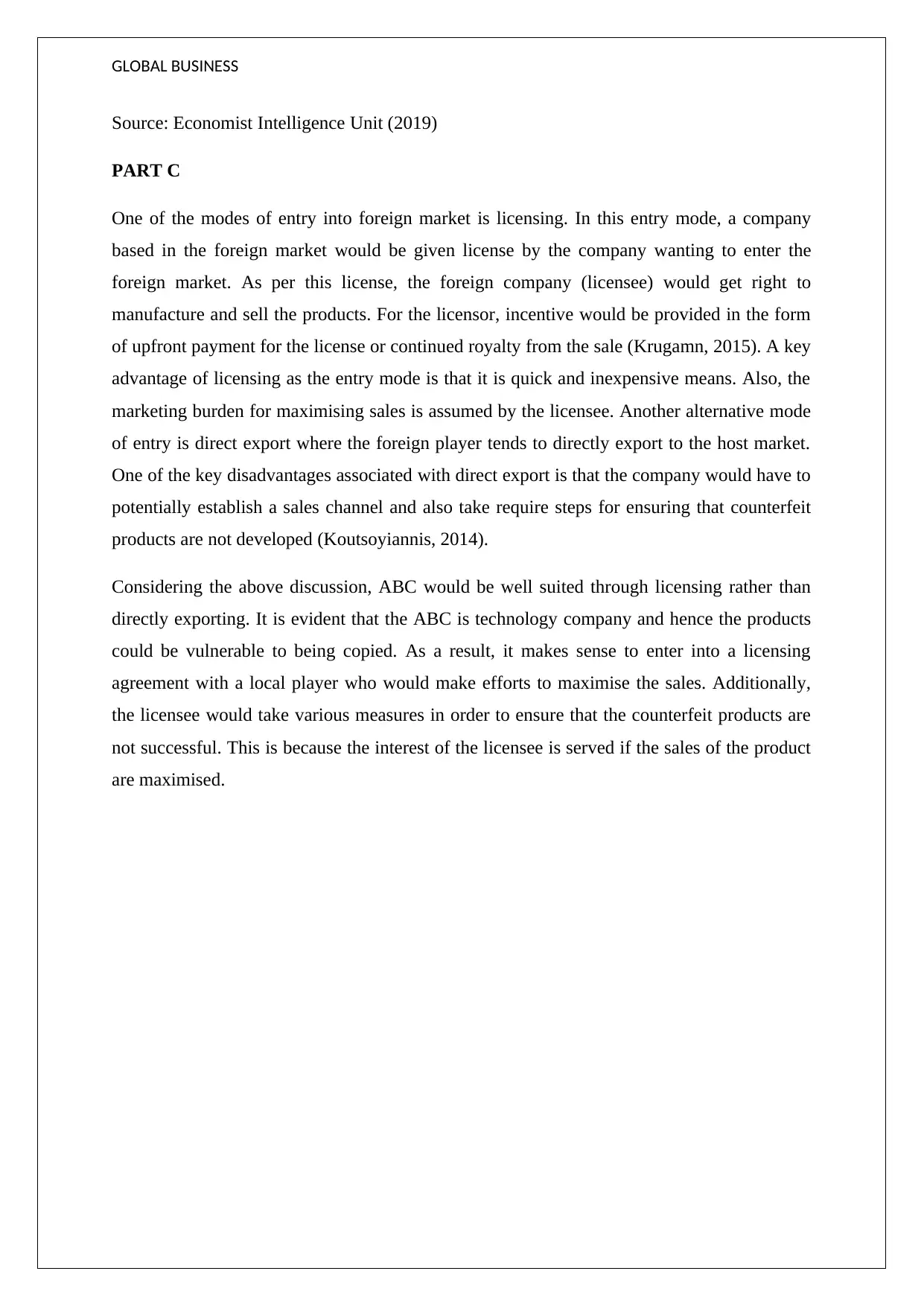
GLOBAL BUSINESS
Source: Economist Intelligence Unit (2019)
PART C
One of the modes of entry into foreign market is licensing. In this entry mode, a company
based in the foreign market would be given license by the company wanting to enter the
foreign market. As per this license, the foreign company (licensee) would get right to
manufacture and sell the products. For the licensor, incentive would be provided in the form
of upfront payment for the license or continued royalty from the sale (Krugamn, 2015). A key
advantage of licensing as the entry mode is that it is quick and inexpensive means. Also, the
marketing burden for maximising sales is assumed by the licensee. Another alternative mode
of entry is direct export where the foreign player tends to directly export to the host market.
One of the key disadvantages associated with direct export is that the company would have to
potentially establish a sales channel and also take require steps for ensuring that counterfeit
products are not developed (Koutsoyiannis, 2014).
Considering the above discussion, ABC would be well suited through licensing rather than
directly exporting. It is evident that the ABC is technology company and hence the products
could be vulnerable to being copied. As a result, it makes sense to enter into a licensing
agreement with a local player who would make efforts to maximise the sales. Additionally,
the licensee would take various measures in order to ensure that the counterfeit products are
not successful. This is because the interest of the licensee is served if the sales of the product
are maximised.
Source: Economist Intelligence Unit (2019)
PART C
One of the modes of entry into foreign market is licensing. In this entry mode, a company
based in the foreign market would be given license by the company wanting to enter the
foreign market. As per this license, the foreign company (licensee) would get right to
manufacture and sell the products. For the licensor, incentive would be provided in the form
of upfront payment for the license or continued royalty from the sale (Krugamn, 2015). A key
advantage of licensing as the entry mode is that it is quick and inexpensive means. Also, the
marketing burden for maximising sales is assumed by the licensee. Another alternative mode
of entry is direct export where the foreign player tends to directly export to the host market.
One of the key disadvantages associated with direct export is that the company would have to
potentially establish a sales channel and also take require steps for ensuring that counterfeit
products are not developed (Koutsoyiannis, 2014).
Considering the above discussion, ABC would be well suited through licensing rather than
directly exporting. It is evident that the ABC is technology company and hence the products
could be vulnerable to being copied. As a result, it makes sense to enter into a licensing
agreement with a local player who would make efforts to maximise the sales. Additionally,
the licensee would take various measures in order to ensure that the counterfeit products are
not successful. This is because the interest of the licensee is served if the sales of the product
are maximised.
Paraphrase This Document
Need a fresh take? Get an instant paraphrase of this document with our AI Paraphraser
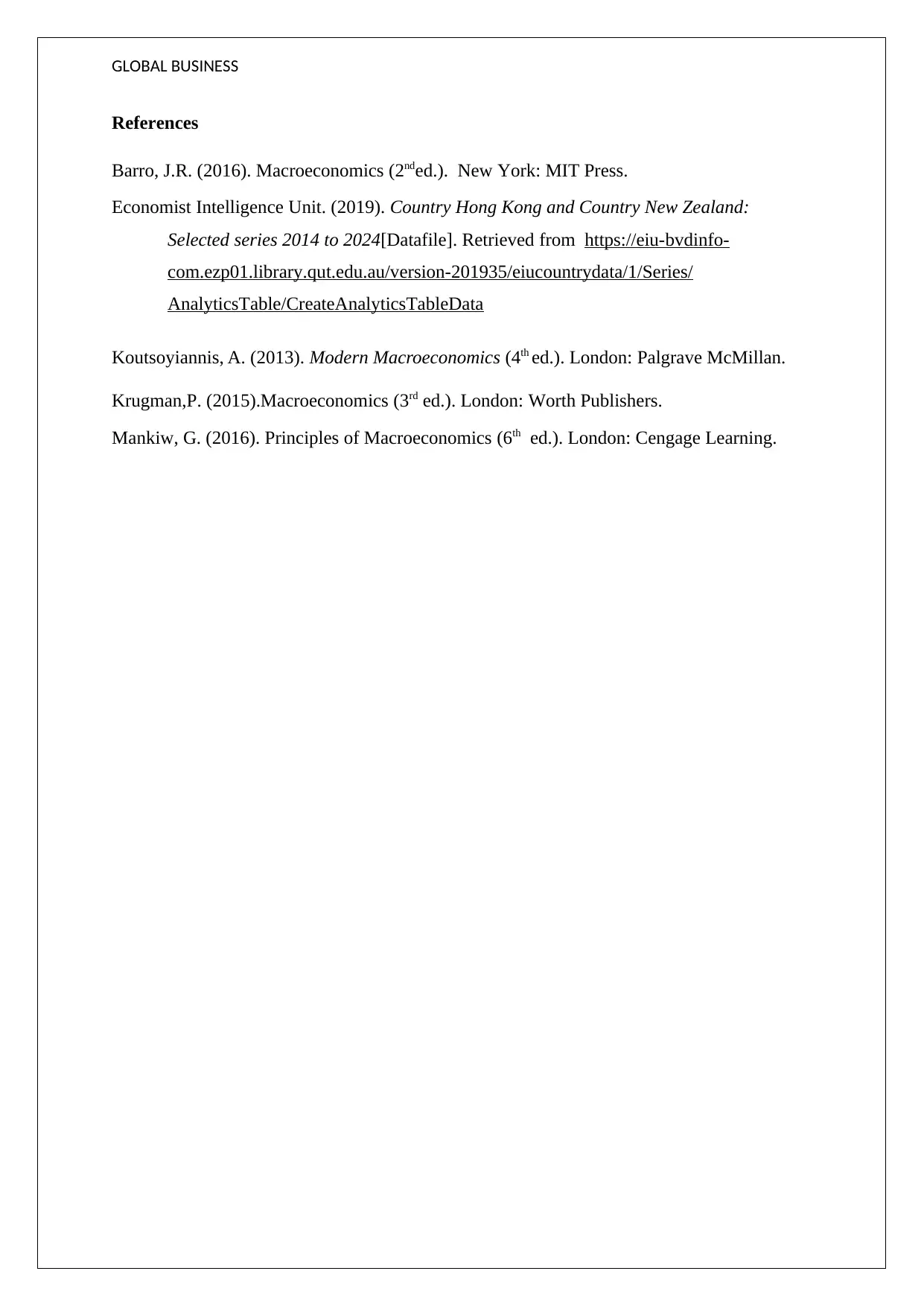
GLOBAL BUSINESS
References
Barro, J.R. (2016). Macroeconomics (2nded.). New York: MIT Press.
Economist Intelligence Unit. (2019). Country Hong Kong and Country New Zealand:
Selected series 2014 to 2024[Datafile]. Retrieved from https://eiu-bvdinfo-
com.ezp01.library.qut.edu.au/version-201935/eiucountrydata/1/Series/
AnalyticsTable/CreateAnalyticsTableData
Koutsoyiannis, A. (2013). Modern Macroeconomics (4th ed.). London: Palgrave McMillan.
Krugman,P. (2015).Macroeconomics (3rd ed.). London: Worth Publishers.
Mankiw, G. (2016). Principles of Macroeconomics (6th ed.). London: Cengage Learning.
References
Barro, J.R. (2016). Macroeconomics (2nded.). New York: MIT Press.
Economist Intelligence Unit. (2019). Country Hong Kong and Country New Zealand:
Selected series 2014 to 2024[Datafile]. Retrieved from https://eiu-bvdinfo-
com.ezp01.library.qut.edu.au/version-201935/eiucountrydata/1/Series/
AnalyticsTable/CreateAnalyticsTableData
Koutsoyiannis, A. (2013). Modern Macroeconomics (4th ed.). London: Palgrave McMillan.
Krugman,P. (2015).Macroeconomics (3rd ed.). London: Worth Publishers.
Mankiw, G. (2016). Principles of Macroeconomics (6th ed.). London: Cengage Learning.
1 out of 5
Related Documents
Your All-in-One AI-Powered Toolkit for Academic Success.
+13062052269
info@desklib.com
Available 24*7 on WhatsApp / Email
![[object Object]](/_next/static/media/star-bottom.7253800d.svg)
Unlock your academic potential
Copyright © 2020–2025 A2Z Services. All Rights Reserved. Developed and managed by ZUCOL.




